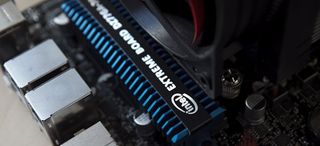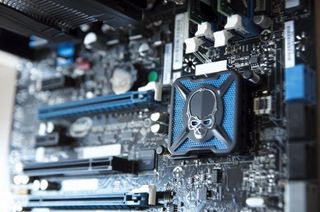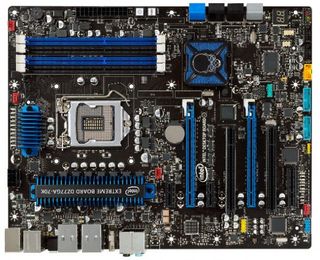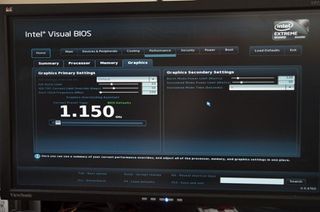Intel intros series 7 motherboards

Easter Sunday. Depending on your ethical proclivities it was a day for church, chocolate or just chilling out playing some games safe in the knowledge that you don't have to work tomorrow. Or, if you're Intel, it's a day for launching your new range of motherboard chipsets and a swanky example of their kind to go with it.
Nope, timing beats me too. Still, I've had one of their new Z77-type boards in the office for a few days now, which is long enough to be suitably impressed with it.
I haven't had time to run a full battery of benchmarks and do a full review, but here's a quick first impressions of what's been included.
The board in question is a DZ77GA-70K , which uses the new Z77 chipset, which in turn replaces the older Z68 . Along with Z77, there are four 'Series 7' mobile chipsets for laptops, Ultrabooks and tablets, and a Z75, H77, B75 to accompany this on the desktop. Still awake? Good, what you need to know is that Z77 has a bunch of new features, and the rest have subsets of them to hit different price points.

One thing that should be made clear from the outset is that this is not an upgrade you need to make if you have a Series 6 (Z68, P67, H61, etc) motherboard already. As far as gaming performance goes, all of the main features are built into the CPU these days, and upgrading the motherboard won't make a blind bit of difference to your generic framerate. Series 7 boards do support the forthcoming Ivy Bridge CPUs, but then so will Series 6 boards if the manufacturer supplies an appropriate BIOS update. Both 7 Series and 6 Series chipsets have a 1155 pin CPU socket that's good for second gen Core processors and up.

The headline improvements over the Z68 are native support for USB and PCI Express 3.0. The latter's only really something you need if you're running multiple GPUs and monitors. Native USB 3.0 in the Southbridge should be more of an obvious attraction, since previous Intel boards used a bridge chip for the perky peripheral port, but in my tests so far it's not as quick as I was expecting. Indeed, copying across a large volume of files to a USB 3.0 hard drive was quicker on an X58 board with a Renasas USB controller on board.
So if performance is a reason to be terribly interested, why have I already developed a bit of an affinity for this board?
PC Gamer Newsletter
Sign up to get the best content of the week, and great gaming deals, as picked by the editors.
The main reason is that it includes things like Intel's Rapid Start Technology, which has previously been used in SSD equipped Ultrabooks to boot in less than 10 seconds. It also features all the best off the previous generation of desktop boards, including SSD-caching technology Smart Response and QuickSync video encoding, accelerated by the hybrid GPU on the CPU die.
It's not perfect, mind – plugging one of Seagate's hybrid Momentous XT drives into a 6Gbps SATA port confused the BIOS to the point that I couldn't even select the drive boot order, although the PC itself seemed unaffected by this quirk.

Perhaps the best thing about it, however, is the rest of the BIOS. Mouse driven GUIs are pretty common now, but the DZ77GA-70K's BIOS is full of sliders and switches for easy overclocking, so much so that all you have to do is move a slider for clockspeed and it automatically adjusts voltage settings as you do. Plus, it has the best sets of tooltips for newbies I've seen, even managing to explain Vdroop in a couple of sentences and why you might want to limit it reasonably clearly.
And, of course, it's very stable at high speeds, but more on that at a later date.

As well as the motherboard, Intel also sent over one of its Centrino Advanced-N 6205 for Desktop WiFi kits, which is a PCI-E add-in board with a dual-band transceiver and trailing dual antenna dongle. It's based on the same adaptor fitted in some Dell laptops, which are available as upgrades for other laptops for around £30-£40. I mention it only because the wireless performance on the 5GHz bandwidth is the best I've ever come across. I'm still not sure I'd use it for a game like Battlefield 3, but latency in SW:TOR is between 30 and 50ms, or very close to the same performance as ethernet in my house. Impressive and cheaper than ethernet over powerline if you need it.
The DZ77GA-70K itself is bound to be pricey - I'd guess around the £200 mark without having shops live to compare it with yet - but a quick scan of Z77 motherboards that have gone on sale already suggests you can pick up something with the same chipset but in a Micro ATX size with fewer ports from around £90 . Which means it makes the older Z68 redundant - and will no doubt be the choice for the next revision of the PC Gamer Rig .
Most Popular

